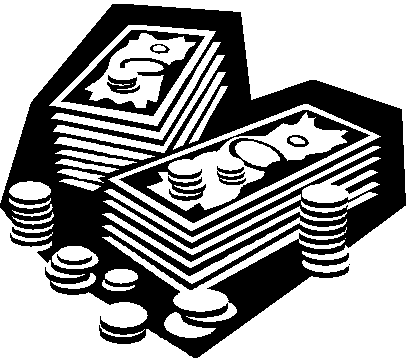What Is Money?
by
Selra H.C. Newrad
"Money is the sinew of love as well as of war."
Thomas Fuller
Econodynamic theoreticians have concerned themselves in the
past few decades with finding fixed points of linear operators.
These fixed points have been instrumental in proving the existence of
competitive equilibria. However, it appears that all the competitive
equilibria have now been discovered, using up all the fixed points and leaving
theoreticians concerned with what to do with the remaining non-fixed points.
This paper, building on the Floating Point Theorem [Newrad, ╦conodynamica,
1991], does not merely extend results on the real effects of money but addresses
the deeper issue of the reality of money.
First, a restatement of the theorem:
Let X be an unbounded subset of Rn , and
let D(X) be the space of bounded, discontinuous functions on X,
with the inf norm. Let F be a subset of D(X) that is
nonempty, closed, bounded, and semi convex. If the mapping T:F
->F is anti-Keynesian and its family is equitable, then T has
floating points in F.
Intuitively, a floating point is a point which is where a
theoretician needs it to be in order to establish a result.
For example, suppose we wish to prove that money has no real
effects (or the even stronger contention that money itself is an illusion).
Suppose not.
Then there exists at least one real agent who behaves as if
money (or its effects) is real. Call this Agent X*.
Set up a one-to-one correspondence between Agent X* and X,
the unbounded subset of Rn mentioned above. Let F be the
set of points in D(X) corresponding to agents who behave as if money is
real. Clearly, F is nonempty since Agent X* has a
point in D(X).
Since the set of economic agents is discontinuous, so is F.
The set of all agents, and, therefore, the set of agents who behave as if money
is real, is obviously closed and bounded unless we extend the analysis to the
infinite horizon (the long, long run).
We next establish semi convexity of F. If F
consists of Agent X* alone, it follows immediately that F
is semi convex. so suppose X1 and X2
are in F. Then, since F is discontinuous, it must be
the case that not all aX1 + (1-a)X2
with a in (0,1) belong to F. Therefore, F is semi convex.
Now let T be the mapping from F to F which
sends Agent X* to a market which clears. then, if Agent X*
has rational expectations, T is anti-Keynesian. Under the
rational expectations assumption, T's family is equitable, so by the
Floating Point Theorem, T has floating points in F.
Let X be
one such point. But this implies there exists another Agent X**
who corresponds to X.
Suppose Agent X** also behaves as if money is real.
Then, since F is semi convex, there exists an Agent X***
and an X# such that aX# + (1-a)X
is not in F. That is, Agent X*** realizes money
is an illusion.
Now since Agent X* is rational and T's
family is equitable, Agent X* must fail to behave as if
money is real. This contradicts our premise. It follows that money
is an illusion.
We believe this result has far reaching implications with
respect to both fiscal and monetary policies.
Promising avenues of research might address such issues as: